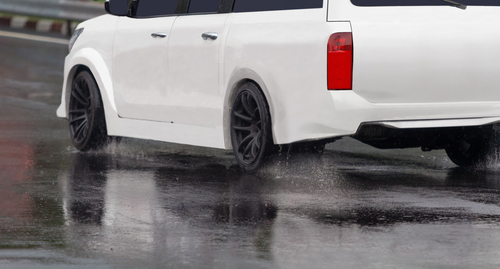Tire maintenance & safety
What is hydroplaning? And how can I prevent it?

Best price guarantee
Tire replacement coverage
24/7 roadside assistance
Easy returns
Tire maintenance & safety

Being behind the wheel of a car is a significant responsibility. At any given moment, things can go wrong, so you need to be ready to act at a moment's notice. Otherwise, the results can be catastrophic.
We say when and not if because this is the kind of mindset you need to have. You always need to be ready for someone to run a red light, for a deer to run out in front of you, and even for the event that you'll wind up hydroplaning.
But what is hydroplaning? Sure, it's a term you might've heard, but not everyone has an in-depth understanding of this phenomenon. Even worse, many drivers don't know what's the best thing to do when it happens. Unfortunately, we can't be there to guide you through this situation physically, but we can break it down in a comprehensive guide we hope keeps you and your loved ones safe.
Hydroplaning is a unique phenomenon that occurs on wet roads. It's a situation when tires are no longer in contact with the ground but are instead gliding across the water on its surface.
The result is an experience much like driving on ice. Turning, stopping, and even acceleration are all diminished.
Hydroplaning can result in total loss of control, and even the best motorists can be taken by surprise and struggle to control their car when it occurs. This loss of control is precisely why it’s the root cause of so many accidents each year.

When can a hydroplane occur? Any time there's a layer of water over the road's surface. Many people make the mistake of believing this only happens when it's raining, or snow is melting. However, blocked drainages, flash flooding, and other scenarios can lead to water on the surface of the road without a single cloud in the sky.
Another potentially deadly situation is when water pools up on a freshly sealed stretch of road. Even after a light rain, a substantial layer of water can remain on the surface because it can't escape quite as easily.
We're not trying to scare you out of driving. We're just trying to drive the point that hydroplaning can occur under circumstances you may not have considered or even knew about. No matter how sunny and warm it is, you always want to watch out for water on the roadways to avoid hydroplaning altogether.
Tires are designed to evacuate any water that exists between the tread and the pavement. Hydroplaning occurs when the tire cannot evacuate the water fast enough to perform this task. Many are under the assumption that speed, the most significant contributor, is the only factor. The weight of the vehicle, the tire design, and the condition of the tire (such as how much tread is left) are also at large.
As a rule of thumb, lighter vehicles will hydroplane easier than heavier vehicles. However, that's not always the case. A smaller car might have better tires than a larger car, and the opposite may be true. The best practice is to avoid the risk altogether regardless of the vehicle you’re driving.
Again, speed is the most significant contributor to hydroplaning, and most vehicles can begin to hydroplane at about 35 miles per hour if there is enough water on the road. Avoiding it can be as simple as slowing down.
However, there are some other factors to be aware of. Not every downpour will lead to hydroplaning. So long as your tires are in good condition, you should manage just fine by only slightly reducing your speed. Remember that a heavy downpour calls for more cautious actions, but you don’t need to go into a panic over a slight trickle.
Let's not rule out the importance of fitting your vehicle with a quality set of tires either. Remember, tires feature grooves and sipes that are specifically designed to extract water that will prevent the tread from gaining or maintaining traction. If the tires are bald, they cannot perform that action. Just another reason to make sure you keep a good set of tires at all times and practice regular tire maintenance.
Slowing down before a hydroplane can occur is easier said than done. You might come over a hill only to find the road dips for a minute, and water has pooled up on the surface. You might not have enough time to slow down in such a situation, and you will hydroplane. What should you do?
We'll talk about the proper action to take in a moment. Before we get to that, we should talk about the appropriate reaction.
Remember what we said about a when, not if mindset. Keeping your bearings is essential. Do your best to remain calm so that you can act accordingly rather than reacting irrationally.
Hitting the brakes can be more deadly in a hydroplane than you would think. For one, you don't have contact with the ground, and it can actually help the tire to continue gliding across the surface of the water. If you hit the brakes and suddenly gain traction, you might wind up spinning out.
Thankfully, modern cars feature anti-lock brake systems (or ABS). While it's still possible to lose control, this system greatly reduces the risk by preventing the wheels from locking up.
You may need to turn the wheel when hydroplaning, but you don't want to turn hard enough to spin the vehicle around. Remember that slow and steady movements are key.

Hydroplaning is an intense experience. Luckily, getting out of the situation is as easy as it is to get into it. The first thing you want to do is let off of the accelerator. Next, you want to gradually steer the car toward a dry portion of the road. Remember not to make any sudden movements as you can wind up spinning out.
But let's say there is no dry portion, and you need to stop as the road takes a hard right or hard left directly ahead. You can begin to apply the brakes, just not rapidly. In an older vehicle without ABS, a steady pumping action can help to break the surface tension allowing the tires to make contact with the road to slow the vehicle down. With ABS, you want to push the brake just hard enough to prevent the system from engaging. Keep in mind that hard braking is not ideal, even with that system.
Rain and water are just a part of life. You can prepare yourself for it, though. Luckily, that's a lot easier to do than you might think, and all it takes is proper tire maintenance. Remember, tire manufacturers have been dealing with rain since the very beginning.
Check your tires' air pressure regularly. Underinflated tires cause increased stopping distance and the risk of hydroplaning. Overinflated tires are just as dangerous. You should check and adjust tire air pressure at least once a month. An added benefit of doing so is preserving tread life which is another great defense against hydroplaning.
Check the tires' treads regularly. IIf they are worn down beyond 2/32nds of an inch in tread depth, they should be replaced. While it may appear to be enough for regular use, the shallow treads will not evacuate water effectively.
All-season, all-weather, and winter tires are usually the best equipped to deal with wet roads. Be sure to look for a tire with sipes and circumferential grooves since both are designed to improve traction in wet weather. However, most tires manufactured for use on public roadways are designed to deal with water. Summer tires might not perform as well on wet roads as the other two, but they should still function just fine for everyday driving.
That said, we cannot stress enough how important it is to practice routine tire maintenance to protect yourself from these situations. Beyond checking inflation and tread depth, you should balance and rotate your tires regularly to prevent uneven wear patterns that could contribute to hydroplaning.
Hydroplaning is something everyone fears, but you don’t have to view it as a situation that will immediately lead to something catastrophic. Mentally preparing yourself and keeping your tires in good shape will ensure you can deal with or avoid the situation appropriately. Of course, we are more than happy to help wherever we can. If you have any questions or are concerned about the condition of your tires, our tire service centers are more than glad to help.
Search By